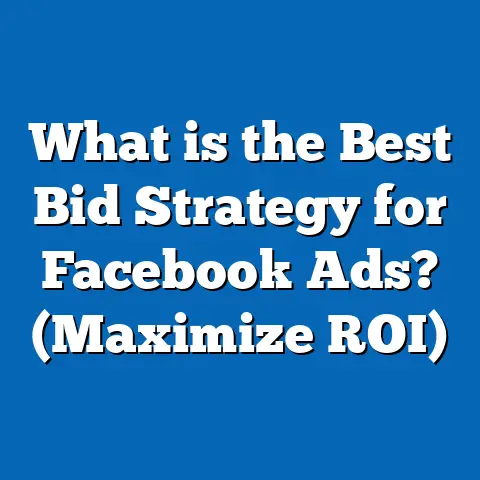What is a Facebook Ad Pixel? (Unlocking Targeted Ads)
Introduction: The Magnetic Power of Facebook Ad Pixel
Imagine a material so unique that it invisibly tracks every visitor stepping into your store, notes their products they lingered on, remembers their interests, and then whispers personalized offers right into their ears whenever they pass by again. This invisible, intelligent material could transform the way you run your business, making every interaction count and turning casual visitors into loyal customers.
This is not science fiction; it’s the magic of the Facebook Ad Pixel—a powerful digital tool that revolutionizes how businesses connect with their audience online.
In today’s digital era, where consumers are bombarded with hundreds of ads daily, generic advertising simply doesn’t cut it anymore. To stand out, marketers need to deliver the right message to the right person at the right time. Facebook Ad Pixel unlocks this level of precision by providing marketers with deep insights into user behavior on their websites and enabling hyper-targeted ad campaigns that convert much better.
What is a Facebook Ad Pixel?
Definition and Purpose
The Facebook Ad Pixel is a snippet of JavaScript code that businesses place on their website pages. It acts like a digital tracking sensor that records actions users take on your website after seeing or clicking a Facebook ad. This data is then sent back to Facebook to:
- Measure how effective your ads are.
- Optimize ad delivery to people who are more likely to take desired actions.
- Create custom audiences for retargeting.
- Build lookalike audiences to reach new potential customers similar to your existing ones.
In essence, the Facebook Pixel links your website activities with your ad campaigns on Facebook, helping you understand user behavior and tailor your marketing accordingly.
How It Works in Simple Terms
When a visitor lands on your website:
- The Facebook Pixel code fires and collects information about the visitor’s actions (like viewing a product or completing a purchase).
- The pixel sends this information back to Facebook servers in real-time.
- Facebook’s ad delivery system uses this data to improve targeting and optimize ad performance.
This process happens silently and automatically but provides powerful insights for advertisers.
Why It’s Essential for Marketers
A survey by Facebook found that advertisers using the Pixel experience up to 20% higher conversion rates than those who don’t. This advantage comes from:
- Ability to target ads based on actual user behavior rather than demographic guesswork.
- Optimizing ad campaigns in real-time based on user interactions.
- Measuring precise return on ad spend (ROAS), allowing smarter budgeting decisions.
Without the pixel, marketers are essentially flying blind, unable to attribute sales or leads back to their Facebook campaigns accurately.
The Technical Anatomy of Facebook Pixel
Installation Process: Step-by-Step
- Create Your Pixel in Facebook Ads Manager
- Log in to Facebook Business Manager.
- Navigate to Events Manager.
- Select “Pixels” and click “Create Pixel.”
- Name your pixel (choose something descriptive).
- Accept terms and generate the base pixel code.
- Add the Pixel Code to Your Website
- Copy the pixel base code.
- Paste it into the header section of every page on your website (between
<head>tags). - For CMS platforms like WordPress, Shopify, or Wix, use their built-in integrations or plugins for easier setup.
- Configure Standard Events
- Add event codes for specific actions like ‘AddToCart,’ ‘Purchase,’ ‘Lead,’ etc., either manually or via platform integration.
- These events help track specific visitor behaviors relevant to your business goals.
- Verify Installation
- Use Facebook’s Pixel Helper Chrome extension to check if the pixel is firing correctly on your website.
- You can also view real-time event tracking in Events Manager.
Types of Events Tracked by Facebook Pixel
Facebook Pixel tracks two main types of events:
- Standard Events: Predefined actions that Facebook recognizes universally. Examples include:
- PageView: Every time a page loads.
- ViewContent: When a product or key content page is viewed.
- AddToCart: When an item is added to a shopping cart.
- InitiateCheckout: When checkout process begins.
- Purchase: When a transaction completes.
- Lead: When a user submits a form or signs up.
- Custom Events: Marketers can define specific actions unique to their business not covered by standard events (e.g., “Download Brochure” or “Clicked Phone Number”).
Advanced Setup: Custom Conversions
Custom conversions allow you to set up conversion tracking based on URL visits or specific parameters rather than events alone. For example:
- Track visits to a “Thank You” page after form submission.
- Define conversions based on query string parameters for more granular attribution.
This flexibility lets you align pixel tracking with complex sales funnels or unique user journeys.
Data-Backed Insights: Why Facebook Pixel Matters
Understanding the measurable impact of Facebook Pixel helps justify its critical role in advertising strategies.
Conversion Tracking Impact: Data & Statistics
- According to a 2023 Facebook Business report, advertisers using the pixel experience an average 20-25% increase in conversion rates compared to those who don’t.
- A study by WordStream found that retargeting campaigns powered by pixel data achieve 70% higher conversion rates than general cold targeting.
- Advertisers leveraging pixel-driven optimization have reported up to a 30% reduction in cost per acquisition (CPA) due to better audience targeting.
Audience Retargeting Effectiveness
Retargeting visitors who showed interest but didn’t convert is one of the most valuable advantages of using the pixel. Key statistics include:
- Retargeted ads average a 10x higher click-through rate (CTR) compared to standard prospecting ads.
- A Criteo study showed that retargeted visitors were 70% more likely to convert on return visits.
- Dynamic product ads with pixel data can boost sales by up to 50% in e-commerce sectors.
Optimization Benefits
Facebook’s algorithm relies heavily on pixel data for machine learning optimization:
- The pixel feeds conversion signals allowing delivery algorithms to find users most likely to take action.
- Advertisers see significant performance improvements when campaigns are optimized for “Conversions” rather than just “Traffic” or “Engagement.”
- In 2024, Facebook introduced Enhanced Conversions and Aggregated Event Measurement features improving data accuracy despite increased privacy restrictions.
Case Study: E-Commerce Brand Boosts Sales with Facebook Pixel
Background
A mid-sized online fashion retailer was struggling with high advertising costs and poor conversion tracking. Their ads generated clicks but few actual purchases, making it difficult to measure ROI accurately.
Strategy Implemented
- Installed the Facebook Pixel across all website pages.
- Configured key standard events: PageView, ViewContent, AddToCart, InitiateCheckout, and Purchase.
- Created custom audiences for users who viewed products but did not complete purchases.
- Launched dynamic retargeting campaigns showing personalized product ads based on browsing behavior.
- Set campaign objectives focused on conversion optimization using pixel data.
Results Achieved in 6 Months
| Metric | Before Pixel Implementation | After Pixel Implementation | % Improvement |
|---|---|---|---|
| Conversion Rate | 1.5% | 1.92% | +28% |
| Cost Per Acquisition (CPA) | $45 | $35 | -22% |
| Return On Ad Spend (ROAS) | 3x | 5x | +66% |
| Average Order Value | $60 | $65 | +8% |
The retailer credited these gains primarily to improved targeting and optimization enabled by the pixel.
Comparing Facebook Pixel with Other Tracking Tools
Google Analytics vs Facebook Pixel
While both tools provide valuable insights, they serve different purposes:
| Feature | Facebook Pixel | Google Analytics |
|---|---|---|
| Primary Focus | Advertising & conversion tracking | Website traffic & behavior analysis |
| User-level Data | Tracks individual users across devices | Aggregated session data |
| Retargeting Capability | Built-in retargeting & custom audiences | Limited retargeting functionality |
| Attribution Model | Last-click & multi-touch conversion | Multi-channel attribution model |
| Integration | Seamless with Facebook Ads platform | Integrates with multiple ad platforms |
When to Use Both:
Use Google Analytics for broad website insights such as traffic sources and behavior flow. Use Facebook Pixel specifically for ad campaign tracking, retargeting, and audience building within Facebook’s ecosystem.
Other Platform Pixels Compared
| Platform | Pixel Name | Main Use |
|---|---|---|
| Google Ads | Google Tag | Conversion tracking & remarketing |
| LinkedIn Ads | LinkedIn Insight Tag | Lead tracking & audience building |
| Twitter Ads | Twitter Pixel | Conversion tracking & retargeting |
Facebook Pixel remains one of the most robust due to its large user base and advanced machine learning capabilities.
Practical Applications of Facebook Pixel
Building Custom Audiences
Facebook Pixel enables creation of audiences based on specific behaviors such as:
- All website visitors (broad retargeting).
- Visitors of particular product pages or categories.
- Users who added items but abandoned checkout.
- Customers who completed purchases (for loyalty campaigns).
You can create audiences with lookback windows from 1 day up to 180 days depending on campaign needs.
Dynamic Ads: Personalized Retargeting at Scale
Dynamic ads use pixel data combined with product catalogs to automatically show relevant products users viewed or added to cart but didn’t buy. This automation eliminates manual ad creation for each item and significantly boosts relevance.
Brands using dynamic ads report an average 30% lift in conversion rates compared to static ads.
Conversion Optimization Campaigns
When creating campaigns optimized for conversions, Facebook leverages pixel data to serve ads preferentially to users similar to those who previously converted. This reduces wasted impressions and improves CPA over time as the algorithm learns more.
Cross-device Tracking and Attribution
Pixel tracks users across multiple devices and browsers when logged into Facebook, providing a clearer picture of user journeys from mobile browsing to desktop purchases. This cross-device insight helps advertisers understand real customer paths often missed by other tools.
Common Challenges and How to Solve Them
Pixel Not Firing Correctly
Common issues include:
- Incorrect placement of pixel code outside header tags.
- Missing event codes for key actions.
- Conflicts with other scripts slowing loading times.
Solution:
Use Facebook’s free Pixel Helper Chrome extension which detects errors and suggests fixes. Also test events through Events Manager debug mode.
Data Privacy Concerns & Compliance
With increasing privacy regulations like GDPR (Europe) and CCPA (California), businesses must:
- Inform visitors about tracking practices via cookie banners or privacy policies.
- Obtain explicit consent where required before firing pixels.
- Use Aggregated Event Measurement protocols supported by Facebook for compliant conversion tracking.
Failure to comply can lead to penalties and loss of user trust.
Attribution Complexity
Facebook Pixel uses last-click attribution by default but offers multi-touch attribution options too. Marketers must understand:
- How attribution windows affect reported results (default is 7-day click + 1-day view).
- Differences between attributed conversions reported by Facebook vs other platforms.
Adjust attribution settings in Ads Manager based on campaign goals for accurate measurement.
Latest Trends and Features in Facebook Pixel (2024 Update)
Enhanced Conversions
Enhanced Conversions use hashed first-party customer data (email, phone number) sent directly from your website through the pixel or Conversions API. This boosts signal accuracy especially when browser cookie tracking is limited.
Benefit: Improves conversion reporting accuracy by up to 20%.
Aggregated Event Measurement (AEM)
Introduced due to Apple’s iOS 14+ privacy changes, AEM limits the number of tracked events per user but prioritizes critical conversion events for measurement while respecting user privacy settings.
Advertisers must configure event priority ranking in Events Manager for optimal results.
Conversions API (CAPI)
This server-side integration sends web event data directly from your server instead of relying solely on browser-based pixels. It increases data reliability by bypassing browser restrictions caused by ad blockers or cookie limitations.
Most advanced advertisers combine pixel + CAPI for maximum tracking fidelity.
Step-by-Step Guide: Setting Up Your First Facebook Pixel Campaign
- Create Your Pixel
In Business Manager → Events Manager → Pixels → Create New Pixel. Name it clearly related to your business or website. - Install Pixel Code
Insert base code into all pages header or use platform-specific integration plugins (Shopify, WooCommerce). - Set Up Key Events
Add standard events such as ‘Purchase’, ‘AddToCart’, ‘Lead’ either manually or via platform tools. - Verify Pixel Operation
Use Pixel Helper Chrome extension and check Events Manager real-time diagnostics. - Create Custom Audiences
Build audiences from pixel data like “All Website Visitors” or “Added To Cart But Didn’t Purchase.” - Launch Conversion Campaigns
Set campaign objective as conversions in Ads Manager targeting your custom audiences or Lookalikes built from them. - Monitor & Optimize
Track results via Ads Manager reports. Adjust audience definitions, budgets, creatives based on performance insights.
Deep Dive: Understanding Audience Types Enabled by Facebook Pixel
Website Custom Audiences (WCAs)
WCAs let you create groups based on specific website behaviors tracked via pixel:
- Visitors of any page
- Visitors during a specific time window (last 30/60/180 days)
- Visitors who viewed certain product/category pages
- Visitors who performed specific events like AddToCart but no purchase
- Visitors segmentable by device type or frequency
Effective use of WCAs allows tiered retargeting funnels—warm audiences closer to purchase get different messaging than cold prospects.
Lookalike Audiences from Pixel Data
Lookalike audiences use pixel-collected data about existing customers/website visitors as seeds. Facebook then identifies people with similar profiles across its network, vastly expanding potential reach efficiently.
Key stats: Lookalike targeting often yields conversion rates 2–3x higher than broad targeting without lookalikes.
Optimizing Campaign Performance with Facebook Pixel Data
Using Conversion Lift Studies
Facebook offers Conversion Lift studies for advertisers wanting independent validation of pixel-driven campaign impact. These tests split audiences randomly into test/control groups measuring incremental lift reliably beyond last-click attribution biases.
Frequency Capping & Audience Saturation Management
Pixel data helps identify when retargeting frequency is too high—leading to ad fatigue—and when audience pools need refreshing or expansion using lookalikes or broader targeting.
Combining Offline Conversion Tracking
For businesses with offline sales processes (e.g., phone orders), integrating offline conversions back into Facebook Ads Manager linked via pixel audiences creates end-to-end attribution—connecting digital touchpoints with offline revenue metrics.
Future Outlook: The Evolving Role of Facebook Pixel in Digital Marketing
With privacy laws tightening and browser changes limiting cookie usage, tracking technologies must adapt continually:
- Server-side APIs like Conversions API will become standard alongside browser pixels.
- Machine learning models will increasingly fill gaps caused by reduced user-level data availability.
- Greater emphasis on aggregated & anonymized data for performance measurement will grow.
- Integration between multiple platforms’ pixels/data sources will provide unified customer views across channels beyond just Facebook.
Staying updated on these innovations ensures marketers maintain competitive advantages through accurate targeting and measurement capabilities.
Final Thoughts: Key Takeaways & Next Steps
- The Facebook Ad Pixel is indispensable for modern digital advertising—offering granular tracking, retargeting, and optimization capabilities.
- Proper installation and configuration are foundational; small errors can cause large data gaps.
- Leveraging pixel data leads directly to higher ROI by focusing ad spend on users most likely to convert.
- Combining pixel insights with other analytics tools enriches marketing intelligence.
- Keep abreast of privacy regulations and new platform features like Enhanced Conversions and Conversions API.
- Start simple with basic events and grow into advanced custom conversions as you mature.
- Test continuously with A/B experiments and conversion lift studies for ongoing improvement.
Unlocking the full potential of the Facebook Ad Pixel means moving beyond generic ads toward truly targeted campaigns that reach the right customers at the right moment—transforming how you grow your business online in measurable ways.
If you want, I can also provide detailed practical tutorials for specific platforms like Shopify or WordPress next, or help create sample campaign templates based on pixel data insights. Just let me know!






